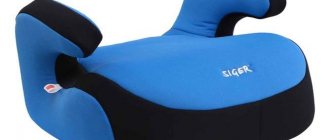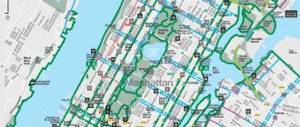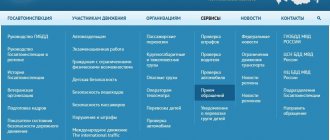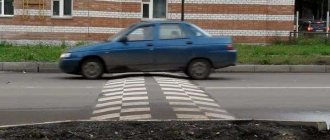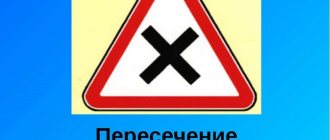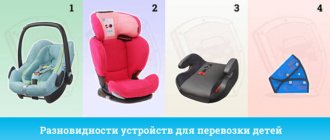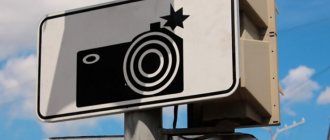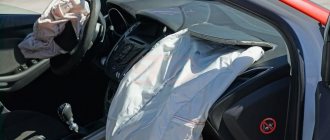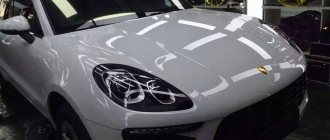Where are the cameras located? Official traffic police card
Yes, there is such a map in 2021. Under the auspices of crime prevention, instead of detection, the traffic police has released and maintains up-to-date an official map where you can see within the region and city where auto registration complexes are located.
The disadvantage of such a traffic police map is that it shows only stationary video cameras. Obviously, the portable tools will not be updated daily. But you won’t find these on other resources either - here only radar detectors can help.
View a map of traffic cameras in Russia on the official website of the State Traffic Safety Inspectorate.
To view the location of cameras, select your region in the drop-down list below the map and enlarge the map itself to find the road you need.
Recommendations for drivers on how to avoid getting caught on police radars
In order to avoid fines from the latest mobile photo-video recording system “OSCON”, a motorist must fulfill at least one of two points:
- Do not violate the Traffic Rules (current version of the traffic rules).
- Have a decent radar detector, preferably a 2018-2019 model year, which will probably already be adapted by the manufacturer for this insidious police speed meter.
Read more information about radar detectors in our article: How to choose a good radar detector. And in the video below, watch a short test of the response range of some models of modern detectors on the OSKON-SM APK.
What types of fixation are there?
Most often, traffic police fines come from cameras when violations are recorded on stationary cameras. These are installed on poles and other supporting structures at the sides of transport arteries and monitor roads around the clock.
Different complexes have different technical characteristics, “farsightedness,” maximum fixation speed and a list of types of violations that they are ready to track.
In addition to them, portable video recording systems are used that “read” only speeding. Along with them, mobile traffic police cameras can also be used - in 2021 they will be installed on patrol cars and public transport. They see not only violations of the speed limit, but also non-compliance with parking rules, passage of heavy equipment and a number of other traffic violations.
And in some regions, the police have even begun to use drones and balloons, but this is more of an experiment than a rule. Let's take a closer look at the main video recording systems.
New cameras 2021
Let's start with the latest and simply new video recording systems that were installed on Russian roads not so long ago. Below we will show you how to find them on the map.
Hummingbird
This is one of the newest video recording systems, which is being actively installed in 2021 on Russian roads. On the map you can find them so far mainly in Moscow and Kazan, but they are also spreading in other cities.
The main advantage of the complex is its size, thanks to which they can be installed easily and in different places. Drivers often don’t notice them and therefore don’t slow down.
You will also be interested in:
- Traffic police cameras in Largus - how legal are they and what violations are they caught for?
- Can traffic police patrol in a civilian or private car, stop and fine?
- We drove under the camera at a yellow traffic light: will there be a fine and how to appeal?
Avtodoriya
This is a hardware and software complex that measures the speed of cars not using radars, but by mathematical calculations of the time it takes a recorded car to cover the distance between several recorders.
The system provides zonal speed control on road sections ranging from 250 meters to 10 km, and therefore it does not matter to the driver what distance he is from the recorder.
That is why there is no point in slowing down when passing Avtodoriya - it calculates the average speed in the section between two cameras.
Avtodoriya, in addition to speed, controls:
- intersection of dividing strips,
- detects violations of parking and stopping rules,
- records driving on the side of the road or in the public transport lane and other violations.
In addition, these traffic police cameras transmit online up-to-date information about the current traffic congestion. In 2021, you can find them on maps of Moscow, St. Petersburg, Kazan, Volgograd, Krasnodar and a number of others - mainly on highways near large cities.
You can see how Avtodoria records violations in the manufacturer’s official video.
How to choose
How Strelka-ST and other chain letter senders work
Choosing a radar detector is not very easy. There are a lot of models on sale - from very budget to premium segment. It is not clear what to choose in such a situation and whether it makes sense to pay more than 10 thousand rubles for the most “sophisticated” device or whether more affordable models will cope with their tasks no worse. As practice shows, the optimal price tag is from 5 to 10 thousand rubles. If the detector is more expensive, then it is either a 3 in 1 (+ navigator and recorder) or it is an overpayment for the brand. As practice shows, there is no point in buying models under 5,000 rubles. Not all, but many of them have false alarms and a small detection radius, that is, they warn about the camera when it is too late and the car comes into view.
So how can you choose the best option so that price and quality match each other? Advice from professionals will help you figure it out.
The first thing to consider when choosing is the types of signals that the car detector can work with. Police radars can operate on the following signals:
- X is an outdated type of signal, which has practically not been used in Russia since 2012;
- K – a new type of signal, operates at an extended frequency, in most cases scanners operate at this frequency;
- Ka – updated K signal, the latest development, practically not found in Russia due to the high cost of the devices;
- Ku is an improved version of Ka; in Russia, at launch, problems with satellite television equipment were discovered, so it was banned, however, in Europe this is the most common signal; if you are planning trips to foreign countries, then the device must be able to detect them;
- L is a signal characteristic of laser scanners, which are the most terrible for motorists, the response speed is so high that it is almost impossible to protect against them, the good news is that such scanners are too expensive and are not found by domestic traffic inspectors.
In addition to the type of signals, users should pay attention to the detection range of cameras; the optimal distance is considered to be 1.5-2 km. A good radar should have several sensitivity modes in the city and on the highway
Separately, it is worth noting the existence of 3-in-1 models, which include a detector, navigator and recorder. They are convenient because they save space, but there are rare cases when all three functions work well. Another type of device is signature-based. Here, radiation is not simply detected, but also analyzed. Based on this, the device is able to understand what the source of the signal is and if it is not a radar or camera, then there will be no notification. Such models often work via GPS and have a radar database, but in this case they are not designed for mobile scanners.
Time-tested complexes
Strelka-CT
Perhaps the most common traffic police video camera on Russian roads is the Strelka ST. She can do the following:
- sees speed limit violators,
- controls traffic in the oncoming lane,
- on the side of the road,
- dedicated lane for public transport,
- crossing the stop line,
- movement of trucks in prohibited places and other violations.
The “vision range” of the camera exceeds 500 m. At this distance, it “catches” the violator in the traffic, “leads” him until he approaches a distance of 50 m, after which he records the violator and his license plate number using a camera. The downside of this system is that it does not respond to objects moving at speeds exceeding 180 km/h.
AvtoUragan-VSM2
This is not just a camera - it is a whole system that combines several photo-video recording complexes, which has a common time synchronization based on a signal from GLONASS/GPS. These traffic police cameras can record 17 types of traffic violations, including:
- over speed,
- driving on red,
- leaving the stop line,
- driving under a prohibiting sign,
- riding on tram tracks,
- sidewalks and bike paths.
The cameras see up to 4 road lanes, record objects at speeds of up to 255 km/h and provide accuracy with an error of no more than 2 km/h.
Odysseus
Autonomous stationary complex consisting of several cameras. It has 12 types of violations that it can capture, including:
- over speed,
- passing a prohibitory signal,
- driving into the oncoming lane,
- turning left or making a U-turn in violation of the markings,
- driving in the opposite direction on a one-way road, and so on.
The camera was created by TCOBDD LLC and reacts to objects moving at speeds of up to 250 km/h. The estimated error is ±1 km/h, the range of operation is classified by the manufacturer. In addition to recording traffic rules, the complex checks license plates for their presence in databases, for example, on the wanted list.
Krechet-SM, SKAT, SKAT-RIF, SKAT-PP
A series of cameras produced by Olvia LLC. Each of them has exceptional specific features. For example, KRECHET-SM provides continuous control with photo recording of all vehicles, SKAT can be used as a stationary or mobile fixing complex, SKAT-RIF works on the same principle as Avtodoriya, providing a mathematical calculation of the speed of movement.
And SKAT-PP is a traffic police camera designed to “catch” traffic violations in the pedestrian crossing area.
Krechet sees intruders in the range of 10-100 m, SKAT in the range of 5-50 m, and for SKAT-RIF such a range does not matter at all. Any of the systems recognizes violators if they move within 250 km/h.
Something else useful for you:
- Is it possible not to pay traffic fines and how?
- Is it possible to order and legally drive without a fine with license plates without the Russian flag?
- The traffic police inspector saw/filmed the violation, but didn’t stop it – what will happen?
Parkon-S
This complex is designed primarily to identify violators of stopping and parking rules. Parkon-S includes several PTZ street cameras controlled from a single center. Today you can find these funds on the maps of most Russian cities.
The system records cars parked in a given area and sends information about them to a single center: two photos with the date and time, license plate number, location and other information. Sees violators both on his own and on the opposite side of the road.
VOCORD Traffic
The VOCORD Traffic system is capable of recording 15 types of violations, including:
- speed limit violation;
- violation of intersection crossing rules;
- intersection of solid lines;
- violation of parking and stopping rules;
- violation in the pedestrian crossing area, etc.
The complex can include various components and measure speed using both detectors (up to 300 km/h) and optics (up to 250 km/h). The developers claim that the system is not recognized by radar detectors, provides 97% reliability of license plate recognition and passes less than 2% of total traffic.
We tested it ourselves - everything is true, everything works
In addition to the above advantages, Neoline X-COP 9300c has several non-obvious but useful features. For example, for the “eye” of the camera, you can additionally purchase an anti-reflective lens, which serves to reduce the amount of sun glare and reflections of interior objects from the windshield in the video.
And the color screen is not only slightly recessed into the body, but also slightly beveled to the left, so that the driver can look at it comfortably without being distracted from the road.
The recorder records in Full-HD, see an example of its operation:
The device has a good matrix from Sony, model IMX 323. The multi-lens lens shoots video with a viewing angle of 130 degrees. Video is processed by the Ambarella A7LA30 processor.
In addition to the Neoline X-COP 9300c, in addition to the standard power cord for the cigarette lighter, you can purchase a separate cable to connect the device directly to the car's power supply. In this case, you can use the parking mode automatically when the car is turned off.
By the way, the device contains a supercapacitor, and not a regular battery. The supercapacitor ensures stable operation of the device at low and high temperatures and has a long service life. Thanks to the supercapacitor, many typical problems are solved: overheating, battery explosion, loss of the “last” files.
During the entire testing period, the device did not miss a single radar, regularly notifying about all cameras, both in front of the car and those striking in the back.
On the case there are several menu control buttons and one “hot” key, which can be programmed with one of the following functions:
● adding a “Danger Zone” point, if a speed bump was suddenly installed ahead ● adding a “Quiet Zone” point, in case of constant false alarms of the detector on the same section of the path ● dimming the screen so that the device does not distract at night track ● emergency recording
Neoline X-COP 9300c has 4 operating modes:
● City (The sensitivity of the device decreases) ● Highway (The sensitivity of the device increases) ● Turbo (The proprietary Z-signature filter is turned off) ● X-COP mode (depending on the current speed of the car, the “city” or “highway” mode is automatically set)
In general, car owners from among their colleagues all gave the Neoline X-COP 9300c a high rating. The device copes well with the functions of both a radar detector and a video recorder.
Neoline X-COP 9300c costs RUB 13,990, but it makes up for every ruble spent with its capabilities. Car enthusiasts, take note.
( 20 votes, overall rating: 4.15 out of 5)
